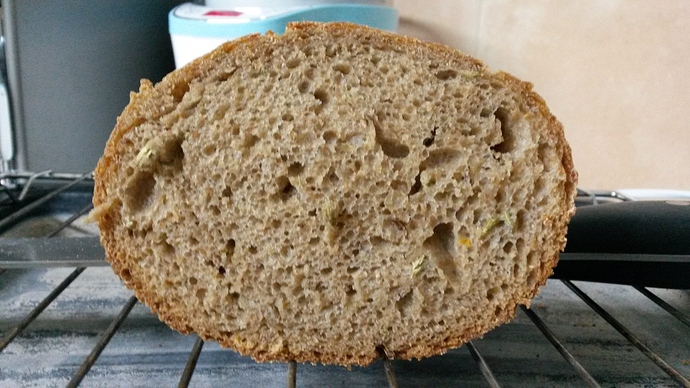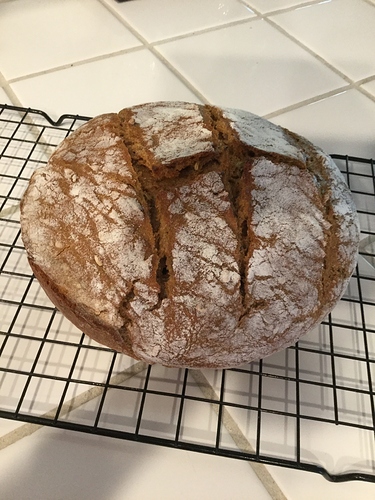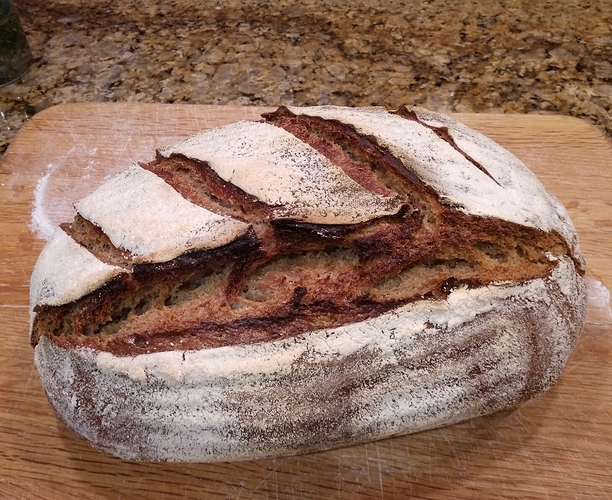I made this, meticulously weighing the ingredients and following the instructors and the vidoes. It was a mess and I threw it away. The dough was so soft it wouldn’t hold its shape and I had to keep incorporating flour into it just to keep it from sticking to the bread board. The whole thing made me angry.
Most doughs are salvageable as long as you don’t panic. If that had happened to me I’d have portioned it out into a bread pan, smoothed it over and final proofed till a few small holes just began appearing on top then baked it.
Thanks, Abe. What I learned was that exact measurement is not helpful. It’s all about texture, density, and feel. I wish these online recipes would explain that. I’m trying another from King Arthur flour and had to add more water than called for because the recipe’s proportions wouldn’t even form a dough mass.
Yes! You’re correct. A recipe is a guideline and you have to allow for differences. Your flour may be different. Temperature will differ depending on where you live. And believe it or not altitude comes into play here as well. But what you’ve done is learn from a mistake so its not a step back but a step forward.
Try it again but remember if it looks like its going to flop bake it anyway! Just get it in that oven even if you have to pour it in a loaf pan. You’ll get something tasty out of it even if it isn’t a fancy loaf but resembling a sandwich loaf instead. When one starts to add flour at that end stage it rarely goes well and even if something does come of it the results are rarely impressive and too often the loaf comes out like a brick.
(Apologies in advance to regulars who are probably sick of me posting this all the time.)
I wrote an article here at Breadtopia that expands on what @anon44372566 summarized economically in his 2 paragraphs above:
Here’s a bit of it:
Ignore the Word ‘Recipe’
Although they tend to be written as though they are, sourdough bread recipes are not like other recipes where you follow an exact procedure using exact measurements with exact temperatures and exact timings. You can treat them like that (and most people do), but if you do, you will not get consistently good results. Sometimes your bread will come out great and other times it will come out not so great. Sometimes a nice rise and “oven spring”, sometimes a dense flat brick or “frisbee”. And if you are conceiving of a ‘recipe’ as a fixed procedure you can use to get a specific result, when things go wrong you will be mystified.
Homebreadbaker Paul, I read your very helpful and affirming article about demystifying sourdough baking. Believe it or not, I have bake a lot of bread in my time, though almost exclusively with the kind of yeast you buy. Today, I tried for a third time and I still have NOTHING even close to what the lovely photos on this site show. My first was Galician Sourdough rye. It looked like an idiotic flying saucer but at least it was edible – though not good. The second was this artisan sourdough rye. Unmitigated disaster. Threw it away. Gross. Disgusting mess. Today I tried yet another and used more flours so that I at least had a dough to work with. Still, as it proofed, it spread out and didn’t really rise at all in the oven. I will wait till tomorrow to cut it open (as directed), but it may be a brick. I just don’t know what I’m doing wrong. So frustrating.
Well, I tried again. The I ignored the recipe and tried to get a dough stiff enough to hold its shape. It started out nice and tall and I had great hopes, but then I baked it and it spread out, did not puff up at all, it looks flat and will probably be like a brick when I cut it.
I really don’t want to give up, but baking anything that has a semblance of bread and tastes good seems like a chimera at this point.
I am not a stupid person. What really makes me angry are things like “this is so easy!” Or “I made it and it turned out beautifully the first time”. It is NOT. And I have now tried three times and it still turned out like crap. And no, Abe, it is obviously not salvageable. Can’t believe I can’t do this.
With this much rye I’d be very surprised if it puffed up tall. Eric baked it in a deep clay baker which would have encouraged a little better rise. If you’re baking it on a stone or oven tray then expect a flatter loaf. I disagree… If you had baked this in a loaf pan (but I understand your reluctance) this is salvageable when it comes to getting a tall loaf however I don’t think a flatter loaf is necessarily a failed loaf. If its flat but has a nice crumb and its tasty then its a winner. So save judgement for when you cut into it and had your first taste.
Now even if you think you have the exact same ingredients you might not. I watched the video and Eric said rye flour and white flour. He ground his own rye berries but if he had a fine grind and you’ve bought a coarser grind then yours will need less water. The recipe doesn’t say what type of white flour. How strong is his bread flour and how strong is yours? Since you’re using 50% rye you have to be going for a very strong bread flour to expect any sort of good rise. 13% + but ideally 14-15% protein. What are you using?
P.s. ignore anyone who says things like “this is so easy”. You don’t know how many flops they’ve had before they started churning out “good” loaves. As a matter of interest how much have you baked with sourdough and rye?
First, I’ve never made this particular “recipe”, so take whatever I say about it with a grain of salt. Second, when I have used rye flour, I don’t think I can remember ever going over about 20% and that has been enough to both make for an interesting flavor addition and also make the dough pretty sticky, hard to handle, and not hold its shape very well.
I think that sourdough bread is both similar enough and different enough from commercial yeast bread that having experience with the latter can be a detriment to learning the former because certain things you have come to expect don’t happen the same way.
So I’d suggest a couple things. First, it might be worthwhile to try a more basic sourdough recipe like @eric’s sourdough no-knead bread. Having success or not with a simple recipe like that will rule out a lot of sources of potential problems.
If you are dead-set on doing this recipe, you could try changing the ingredients to 400g bread flour and 100g rye flour and then start with 350g of water and see how the dough feels when it’s all mixed up. Add more water a little at a time if it seems too dry. See how it works with a higher proportion of bread flour.
Aside from ingredients issues, getting a soupy dough that won’t hold its shape, or falls down in the oven can be the result of over-proofing with sourdough. So really keep an eye on the proofing process and make sure that you have a feeling for when the rise is peaking and err on the side of ending the bulk fermentation too soon rather than too late until you get to where you have enough feeling for it to hit it on the head exactly.
So best way to see what’s going on is to try it for myself @emetzler and @homebreadbaker. Decided to try it at the last moment so had to make some slight adjustments like so…
1: Had no anise seed so used extra fennel instead. Between caraway and fennel I think fennel is most like anise seed.
2: Instead of using the usual molasses I used carob molasses instead. It is more liquid than the thick viscous cane molasses.
3: Had no oranges and even if I did I have no zester. So I used 20g orange marmalade jam instead. Don’t know if a perfect substitute but should be interesting!
4: Because of points 2 & 3, the more liquid molasses and the 20g jam, I reduced the water by 20g to try and get the same properties for the final dough when it comes to hydration. It seemed to give me a good result which was very similar to Eric’s dough.
The bread flour I used was a very strong 15% protein Canadian flour by Marriage’s and I used Dove’s Farm wholegrain rye.
The dough was sticky however by the time I finished the last of the stirring folding kneading alternative method it had strengthened up very well. The dough was holding itself together and had strength to it even though it was sticky. Left it to bulk ferment overnight.
This morning it was very well risen, much more so than Eric’s dough in the video, and seemed over done and far too sticky to handle just by looking at it however when doing the folds the dough soon tightened up and had a good strong structure. Shaping was not as difficult as I thought it might be just by looking at the risen dough.
I did not final proof in a basket. As per Eric’s advice, and I can see what he means, this dough would really suit a cloth lined banneton due to its sticky nature. So I final proofed and baked it in a lekue - silicone pouch. More support than freestanding or in a cloche but more room to expand then a loaf pan. While this method of baking obviously gave me a big advantage for a tall loaf I have to say even I was surprised. I’ve done other less challenging loaves this way which produced less oven spring so while I was expecting this method to help I wasn’t expecting such good results. This loaf exceeded my expectations and while I would have lost height on a stone or in a cloche I think there’s still potential for good oven spring. Something which I suspected when shaping due to feeling how much strength it had and a good gluten formation.
Just cut into it and had a taste. Wow! This is one heck of a delicious loaf. I’m sold on this recipe. Texture and flavour are spot on. Thank you Eric.
Abe, How do I PM you? I will send you more information. Perhaps you will be able to help me. ~Eric
I’ve sent you a PM. You should have received a notification so all you need to do is reply.
Thanks, Abe. Where do I look for the private message? I don’t see anything on this site. I have not received anything from you anywhere that I can see.
OK… Let me see
Top right hand corner you should see your avatar or picture. For you it’ll be an upper case “E” within a red circle. Click on that and then you should have a drop down box. Click on the picture of an envelope and you should see my PM.
I suspect I’m having trouble with private messaging because I’m a new user. In the help section, it says there are things unavailable to me until “I gain the trust of the community.”
Well you have my trust 
We have bestowed upon thee community trust. Go ye forth and make bread!
I’m new to Breadtopia and fairly new to sourdough. This recipe sounded so delicious that I couldn’t resist! Thanks to Eriks clear directions and helpful video, I am delighted with my first attempt with rye! Thanks so much!
Hi Eric,
Been using your starter and recipes for a year now and all the daughters bought my Christmas presents from Breadtopia!
Question on the Rye recipe. Could I make this in a loaf pan with good results?
Thanks, WIll



